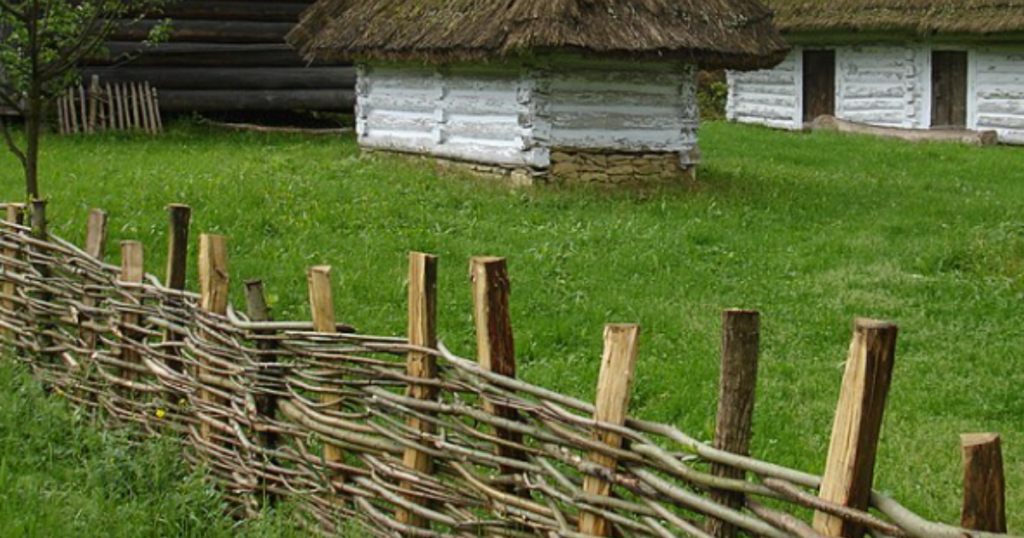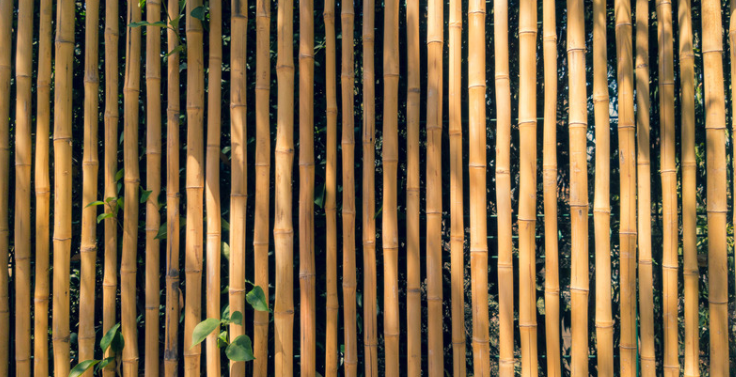Have you ever wondered if a natural fence is right for your yard? There are many reasons why it could be.
Natural fences are made from materials that grow back and require little maintenance, which makes them much better for the environment than traditional wooden or metal fences.
They also don’t need toxic chemicals like paint or stain, so they won’t pollute your soil or groundwater as quickly as other types of fencing might.
Natural fences are more eco-friendly than traditional wooden or metal fencing and can also look beautiful.
Below are some of the best types of natural fences to consider installing in your yard.
Table of Contents
1. Bamboo fencing
Bamboo fencing is an excellent option to create a living fence, it also provides great privacy, blocking out noise, light, and wind. In addition, bamboo grows at an impressive rate—it can reach 10 feet in just three years. Bamboo fencing is also a good way of providing natural shade for your yard or garden.
Bamboo is a highly fast-growing grass that can easily be cut down to size as it grows taller than you want. As a result, bamboo doesn’t need much maintenance and will provide privacy year-round without any upkeep on your part.
2. Twig Fencing

A wattle fence at Sanok-Skansen outdoor museum in Poland
Twig fences, also known as wattle fences, are made of twigs and branches held together by steel wire. They can be built and constructed in a variety of ways.
First and foremost, twig fencing is beautiful. It has a rustic, homey look which is perfect for any natural or rustic-style home. It can be used as a fence alone, or you can incorporate it into your existing fence to make it more interesting and appealing.
It’s also highly durable and long-lasting—twig fences are made from strong tree branches that have been cut at an angle and then nailed together tightly. The result is a sturdy but lightweight barrier that will last for years without needing replacement or repair.
The best part about twig fencing is that it’s incredibly affordable!
Learn how to attract beneficial insects to your garden here.
3. Natural Reed Garden Fencing
You can plant reeds for a natural, quick-growing fence that provides privacy and looks beautiful. They’re also easy to maintain and will give you years of enjoyment with minimal upkeep.
- Reed plants are one of the most popular choices for creating a living fence because they grow quickly, so you can enjoy your new fence in no time.
- One of the best things about using reed plants as your natural fencing is how simple it is to install—you don’t need any special tools or supplies! Just dig up some soil from the area where you want to install the reeds and spread it out evenly over top of an existing lawn or ground cover (if applicable). Then place your reeds into this prepared soil bed until they look like they’re standing upright on their own accord. That’s all there is too it!
4. Boxwood hedges
If you’re looking for a classic, natural looking fence that requires little maintenance, boxwood hedges are the way to go. Boxwood is a fast-growing evergreen shrub with small leaves and is often used as an ornamental hedge or screen. It can grow up to 10 plus feet in height and 5 feet wide; however, it can be pruned back if you want it to grow shorter.
If you’re interested in using your fence as more than just something that separates your property from that of your neighbor’s—like when privacy is more important than anything else—boxwood hedges are also a great option because they provide ample privacy while still looking natural and beautiful!
5. Honey locust trees
When it comes to living fences that are easy on the eyes, honey locust trees are hard to beat. The trees have glossy green foliage that will turn a vibrant yellow in the fall and can easily reach heights of up to 60 feet. They also make great alternatives for erosion control, as they have deep roots that reach up to 30 feet underground.
6. Green hedge walls

A clipped beech hedge in Germany
Green hedge walls are a natural-looking way to create privacy in your backyard. They can be built with plants that are known for their dense foliage.
If you’re looking for a better option than a thin line of shrubs or vines along the edge of your property, consider using multiple layers instead (this is called layering). A combination of different types of shrubs and vines layered together can create both depth and texture—and there’s no limit to what kind!
7. Prickly hedges
Prickly hedges are an excellent natural barrier to create privacy and block the view of your neighbor’s property, street or house. They also serve as a windbreak, helping to reduce noise and protect against strong winds.
The only problem is that they can be a bit unruly if they’re not properly maintained. Choose prickly hedges like boxwood or yew if you want something more formal, which will require occasional trimming to keep them looking neat and tidy.
8. Creeping Ivy
Creeping ivy is another excellent option for a living fence. This hardy plant grows quickly and can be used to cover fences or walls, making it a great choice if you need a tall privacy screen.
Creeping ivy can also be pruned into formal hedges, or trained to grow up trellises for an attractive topiary look.
9. A simple cedar fence
Cedar is a great option for a natural-looking fence. It’s durable, long-lasting and will stand up to the elements. If you have the right climate, cedar can grow to be over 120 feet tall and 15 feet wide.
Cedar is most commonly used in outdoor projects because it’s resistant to rot, insects and fungi. Cedar wood is also resistant to termites and other wood-boring insects that can plague many other types of fencing materials (even treated wood). This means you won’t have to worry about your cedar fence needing replacement anytime soon!
10. Cactus
Cacti are hardy plants that grow well in the desert. They are drought-tolerant, which makes them a great choice for a natural fence.
It is also low maintenance and can be planted in a variety of ways: upright, hung from posts or wires, or even used as an ornamental accent plant. The cactus plant comes in many shapes and sizes—some are squatty while others grow tall—and they come in different colors and shades too!
11. Willow Tress
Willow trees are fast growing, making them a good choice for a living fence. Willow trees can be planted in a variety of soil conditions and are drought tolerant. It’s also beneficial for wildlife habitat. If you want to make your willow tree look more formal, then pruning and shaping it is an option as well!
12. Privet
Privet are a great option for creating an natural fence for your property. They are very hardy and can withstand a lot of abuse.
The privet plant is also known as “Japanese privet” and “hedge privet”. The plant can grow to over 10 feet in height, with dark vibrant green leaves that turn reddish in the fall. Privets are very tolerant of drought conditions, and they usually prefer full sun or partial shade.
Privets don’t require much care, and they make excellent privacy screens or windbreaks. The plants can also be pruned into hedges that grow between 2-3 feet tall.
When planting privets, keep in mind that they have shallow roots that can spread over time.
If you plan is to use them as a screen or windbreak, you should consider planting them in clusters rather than lining them up next to each other directly along the line of your fence line – otherwise they’ll start leaning toward each other over time and eventually fall over!
13. Junipers
Junipers are a good choice for a living fence because they are evergreen. If you live in a climate with colder winters, you may want to use juniper as a hedge or privacy screen.
The dense, upright form of junipers make them ideal for creating living fences or windbreaks. Junipers can be trained to grow in a variety of shapes such as mounded, pyramidal and weeping forms.
The plants can also take on the form of bonsai trees when given enough space to grow vertically.
14. Forsythia
Forsythia is a deciduous flowering shrub that can grow to be 6 feet tall. The flowers are yellow, and they appear in early spring. If you have a lot of space, forsythia is a good choice for your living fence because it can be clipped into shape and used as an ornamental hedge.
Forsythia also makes for a good privacy screen because its dense growth allows no visibility through it from the other side.
15. Holly
Holly trees are native to North America and can be found growing in USDA zones 4 to 9. They’re evergreen, which means they don’t lose their leaves during the winter months, and they make excellent windbreaks or privacy hedges.
These also make good shade trees for fruit orchards, which is why many farmers plant them as part of their hedgerows.
Hollies are quite hardy: they grow exceptionally well in drier areas with poor soil and very little water. They’re drought tolerant and resist disease better than most other shrubs or trees do—which makes them a perfect choice for your backyard landscape project!
Conclusion
This list of natural living fence ideas might help you create the perfect fence for your property without spending a fortune on materials or sacrificing the style of your backyard sanctuary.
Living fences can be made out of all kinds of materials including bamboo trees, flowering vines such as wisteria or clematis vines, fruit trees like apples and pears…or even bamboo!
Learn how to make compost here.

